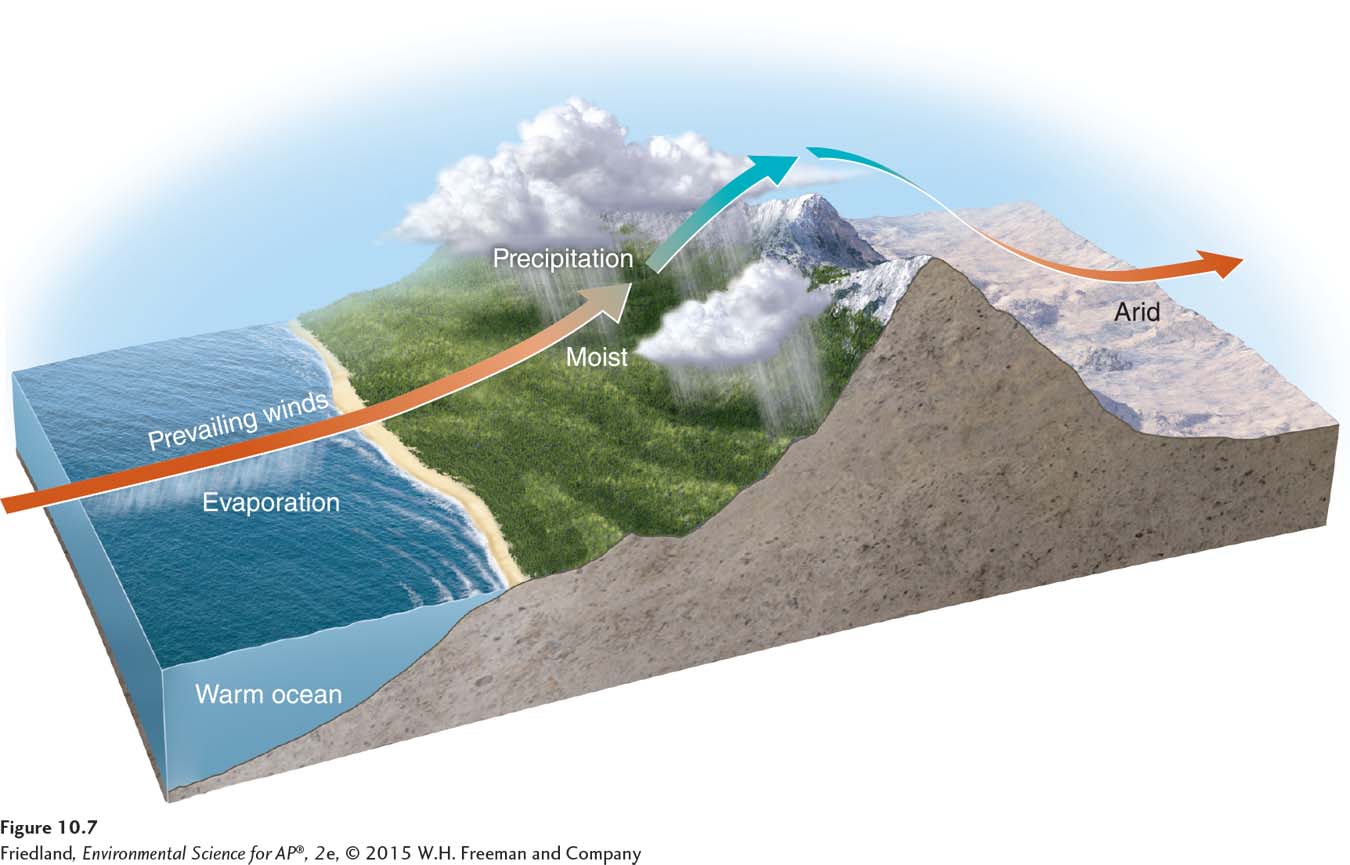module 10 Air Currents
The unequal heating of Earth has wide-
Learning Objectives
After reading this module you should be able to
explain how the properties of air affect the way it moves in the atmosphere.
identify the factors that drive atmospheric convection currents.
describe how Earth’s rotation affects the movement of air currents.
explain how the movement of air currents over mountain ranges affects climates.
Air has several important properties that determine how it circulates in the atmosphere
Air has four properties that determine how it circulates in the atmosphere: density, water vapor capacity, adiabatic heating or cooling, and latent heat release.
The first property is air density, which is the mass of all molecules in the air in a given volume. The density of air determines its movement: Less dense air rises, whereas denser air sinks. At a constant atmospheric pressure, warm air has a lower density than cold air. Because of this density difference, warm air rises, whether in a room in your house or in the atmosphere.
Saturation point The maximum amount of water vapor in the air at a given temperature.
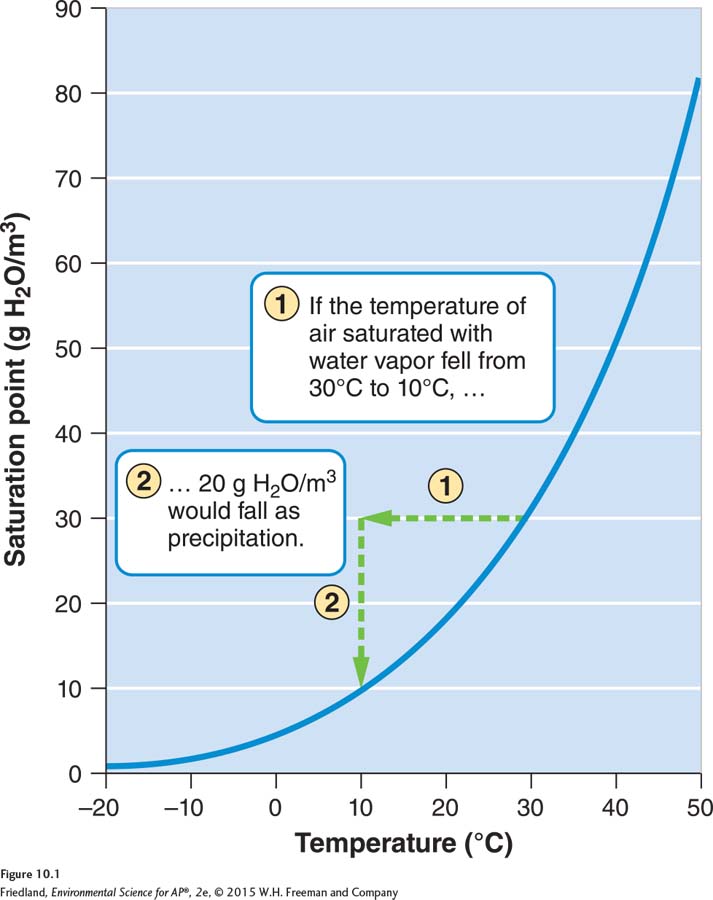
The second property that determines how air circulates is its capacity to contain water vapor. For example, warm air is not only less dense than cold air, it also has a higher capacity for water vapor. In regions of the world that receive substantial amounts of precipitation, hot summer days are associated with high humidity because the warm air contains a lot of water vapor. The maximum amount of water vapor that can be in the air at a given temperature is called its saturation point. FIGURE 10.1 shows the relationship between the temperature of air and its saturation point. When the temperature of air falls, its saturation point decreases, water vapor condenses into liquid water, clouds form, and precipitation occurs.
Adiabatic cooling The cooling effect of reduced pressure on air as it rises higher in the atmosphere and expands.
Adiabatic heating The heating effect of increased pressure on air as it sinks toward the surface of Earth and decreases in volume.
A third property of air is its response to changes in pressure. As air rises higher in the atmosphere, the pressure on it decreases. The lower pressure allows the rising air to expand in volume, and this expansion lowers the temperature of the air. The cooling effect of reduced pressure on air as it rises in the atmosphere and expands is called adiabatic cooling. Conversely, when air sinks toward Earth’s surface, the pressure on it increases. The higher pressure forces the air to decrease in volume, and this decrease raises the temperature of the air. The heating effect of increased pressure on air as it sinks toward the surface of Earth and decreases in volume is called adiabatic heating.
Latent heat release The release of energy when water vapor in the atmosphere condenses into liquid water.
The final property of air that determines how it circulates is the production of heat when water vapor condenses from a gas to a liquid. As you may know, the Sun provides the energy necessary to evaporate water on Earth’s surface and convert it into water vapor, which enters the atmosphere. In the reverse process, when water vapor in the atmosphere condenses into liquid water, energy is released as heat. The release of energy when water vapor in the atmosphere condenses into liquid is known as latent heat release. Because of latent heat release, whenever water vapor in the atmosphere condenses, the air will become warmer and rise in the atmosphere.
Atmospheric convection currents move air and moisture around the globe
Atmospheric convection current Global patterns of air movement that are initiated by the unequal heating of Earth.
A major contributor to the different climates of the world is atmospheric convection currents. Atmospheric convection currents are global patterns of air movement that are initiated by the unequal heating of Earth. These air currents are called convection currents because they involve the movement of air that absorbs and releases heat as the air moves up into the atmosphere and then back to Earth. Now that we understand the four properties of air, we can look at how these properties contribute to atmospheric convection currents. In the next section we will consider how these atmospheric currents are deflected by Earth’s rotation.
We can examine how atmospheric currents develop in FIGURE 10.2. The warming of humid air at Earth’s surface decreases the density of the air. As a result, the air begins to rise and, as it does, it begins to experience lower atmospheric pressures and adiabatic cooling. The cooling causes the air to reach its saturation point, which leads to condensation that causes cloud formation and precipitation. Condensation also causes latent heat release, which offsets some of the adiabatic cooling and becomes a strong driving force to make the air expand further and rise higher. Collectively, these processes cause air to rise continuously from Earth’s surface near the equator, forming a river of air flowing upward into the troposphere.
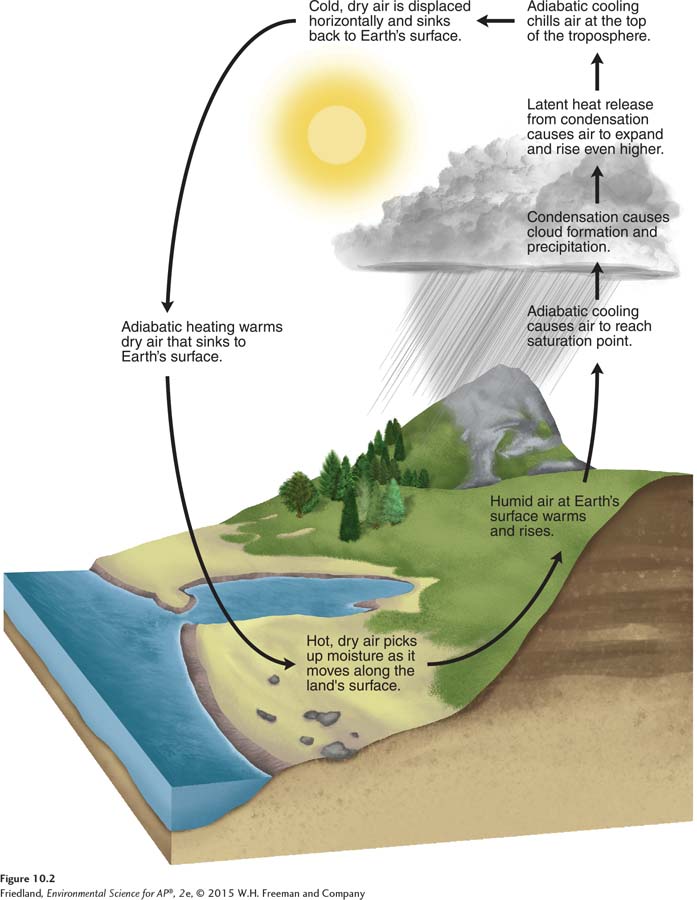
As the air reaches the top of the troposphere, it is chilled by adiabatic cooling. This air now contains relatively little water vapor. As warmer air continually rises from below, the cold, dry air at the top of the troposphere is displaced horizontally and eventually begins to sink back to Earth’s surface. As the air sinks, it experiences higher atmospheric pressures, and its reduction in volume causes adiabatic heating. By the time the air reaches Earth’s surface, it is hot and dry. This hot and dry air circulates back to the starting point and picks up moisture along the way.
Hadley cell A convection current in the atmosphere that cycles between the equator and 30° N and 30° S.
Atmospheric convection currents on Earth are found at specific locations. For example, Hadley cells are convection currents that cycle between the equator and approximately 30° N and 30° S. In a Hadley cell, illustrated in FIGURE 10.3, the unequal warming of the tropics causes the air near the equator to expand and rise. This rising air cools and the condensed water falls as precipitation over the tropics. After being chilled by adiabatic cooling near the top of the troposphere, the cold dry air is displaced horizontally north and south of the equator. This air descends back to Earth at approximately 30° N and 30° S. As it sinks, adiabatic heating causes the air to warm. As a result, regions at 30° N and 30° S are typically hot, dry deserts. Once the warm, dry air reaches Earth, it flows back toward the equator to complete the cycle.
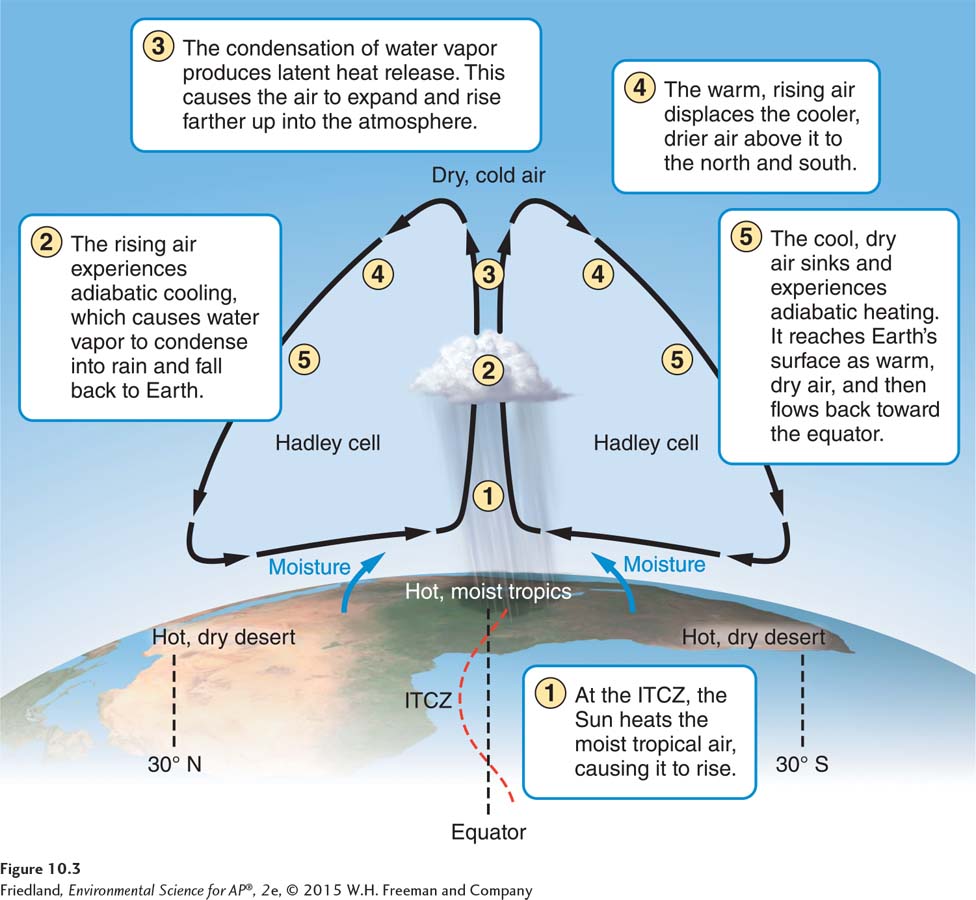
Intertropical convergence zone (ITCZ) The latitude that receives the most intense sunlight, which causes the ascending branches of the two Hadley cells to converge.
The circulation of the Hadley cells is driven by the intense solar energy that strikes Earth near the equator. The latitude that receives the most intense sunlight, which causes the ascending branches of the two Hadley cells to converge, is called the intertropical convergence zone (ITCZ). Because humid air rises at this latitude and precipitation falls, the ITCZ is typified by dense clouds and intense thunderstorm activity.
The latitude of the ITCZ is not fixed. Because Earth’s axis of rotation is tilted, the area receiving the most intense sunlight shifts between approximately 23.5° N and 23.5° S as Earth orbits the Sun. Because the ITCZ occurs at the latitudes that receive the most intense sunlight, the ITCZ moves north and south of the equator over the course of a year. As a result, the tropics experience seasons of high and low precipitation.
Polar cell A convection current in the atmosphere, formed by air that rises at 60° N and 60° S and sinks at the poles, 90° N and 90° S.
Another set of atmospheric convection currents occur near the poles. Polar cells are convection currents formed by air that rises at 60° N and 60° S and sinks at the poles (90° N and 90° S). At 60° N and 60° S, the rising air cools and the water vapor condenses into precipitation. The air dries as it moves toward the poles, where it sinks back to Earth’s surface. At the poles, the air moves back toward 60° N and 60° S, completing the cycle.
Ferrell cell A convection current in the atmosphere that lies between Hadley cells and polar cells.
A third convection current, known as Ferrell cells, lies between Hadley cells and polar cells. Air currents at these latitudes do not form distinct convection cells, but are driven by the circulation of the neighboring Hadley cells and polar cells. At Earth’s surface, some of the warmer air from the Hadley cells moves toward the poles from 30° N and 30° S, and some of the cooler air from the polar cells moves toward the equator from 60° N and 60° S. This movement not only helps to distribute warm air away from the tropics and cold air away from the poles, but also allows a wide range of warm and cold air currents to circulate between 30° and 60°. In this latitudinal range, which includes most of the United States, wind direction can be quite variable, both at Earth’s surface and at the top of the troposphere.
Collectively, these convection currents slowly move the warm air of the tropics toward the mid-
Earth’s rotation causes the Coriolis effect
Coriolis effect The deflection of an object’s path due to the rotation of Earth.
The atmospheric convection currents cause air to move directly north or south. However, the actual air currents at Earth’s surface are deflected to the east or west because our planet is rotating. The rotation of Earth causes the deflection of objects that are moving directly north or south, a phenomenon that we call the Coriolis (core-


The deflection of objects moving north or south occurs because the planet’s surface moves much faster at the equator than at higher latitudes. The planet’s circumference is 40,000 km (25,000 miles) at the equator, but decreases to 7,000 km (4,350 miles) at 80° N or 80° S latitude. Now imagine traveling all the way around Earth in 24 hours at the equator versus at 80° N latitude. FIGURE 10.5 will help you visualize this journey. At the equator, you must travel 40,000 km; at 80° N latitude you must travel only 7,000 km. To make the trips in 24 hours, you must travel much faster at the equator. Indeed, Earth’s surface moves at 1,670 km per hour (1,038 miles per hour) at the equator but only 291 km per hour (181 miles per hour) at 80° N or 80° S.
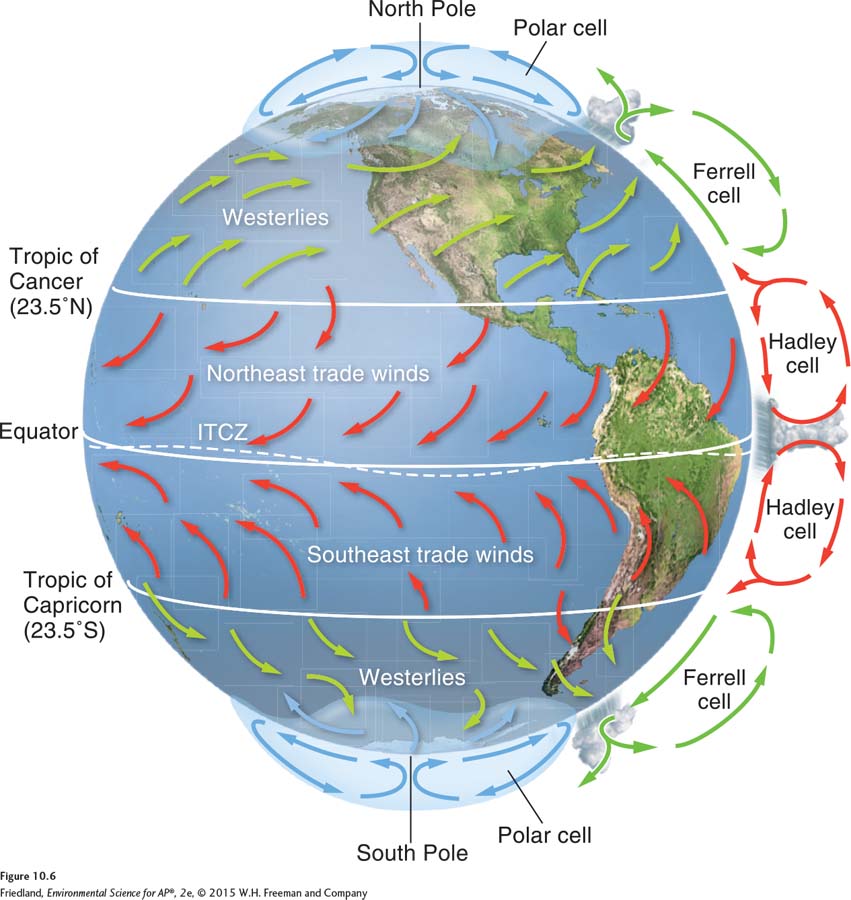
If Earth did not rotate, the air in the convection cells that we discussed earlier would simply move directly north or south and cycle back again. For example, the air in a Hadley cell sinks to Earth’s surface at approximately 30° latitude and travels along Earth’s surface toward the equator. However, the Coriolis effect produced by Earth’s rotation deflects the path of atmospheric convection currents that move toward or away from the equator, as we can see in FIGURE 10.6. Because Earth’s speed of rotation is faster near the equator, the path of the air current moving toward the equator is deflected to the west, just as we saw in our example of throwing a ball toward the equator. This deflection causes the Hadley cell north of the equator to produce prevailing winds along Earth’s surface that come from the northeast (called northeast trade winds), whereas the cell south of the equator produces prevailing winds that come from the southeast (called southeast trade winds).
The Coriolis effect also explains the prevailing wind directions in the mid-
Finally, the Coriolis effect helps us understand the prevailing wind directions in the polar regions. Along Earth’s surface, the polar cells move air away from the poles and toward 60° latitude. Since Earth is rotating faster at 60° than it is at 90°, the air movement is deflected to the west. As a result, polar winds come out of the northeast in the Northern Hemisphere and out of the southeast in the Southern Hemisphere. These winds are called easterlies.
Rain shadows cause mountains to be dry on one side
Rain shadow A region with dry conditions found on the leeward side of a mountain range as a result of humid winds from the ocean causing precipitation on the windward side.
Although many processes that affect weather and climate operate on a global scale, local features, such as mountain ranges, can also play a role. Air moving inland from the ocean often contains a large amount of water vapor. As shown in FIGURE 10.7, when this air meets the windward side of a mountain range—
